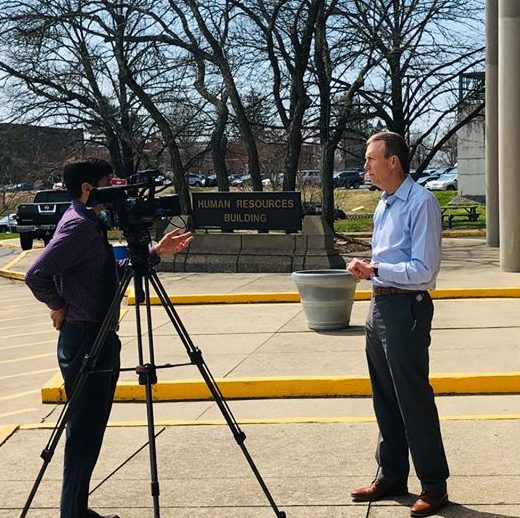A new study released Tuesday by three environmental groups found more than half of West Virginia counties rank among the worst in the nation for violations of a federal law that protects the quality of drinking water in the U.S.
The report, “Watered Down Justice,” ranked 36 of the state’s 55 counties among the top third worst-offending U.S. counties.
The analysis found millions of people across the country, including thousands in West Virginia, consumed water from drinking systems that were out of compliance with the U.S. Safe Drinking Water Act (SDWA). Small, often rural, community water systems were among the top offenders, along with systems responsible for serving communities of color and low socioeconomic conditions.
In West Virginia, where much of the state’s residents live rurally, many people depend on small community water systems.
Systems nationwide serving less than 3,300 people accounted for more than 80 percent of all SDWA violations, according to the study. Even smaller systems, serving less than 500 people, were reportedly responsible for more than 60 percent of all SDWA violations, and for 50 percent of health-based violations.
At a press conference at the Capitol in Charleston Tuesday afternoon, a series of speakers, including two state lawmakers and representatives from environmental groups, said the study not only found West Virginia counties violated the SDWA often, but also spent a lot of time not complying with the law in general. According to the report, 42 West Virginia counties are among the top third in the nation for counties who spend the most time out of compliance.
What Is The SDWA?
Three environmental groups — the Natural Resources Defense Council, Coming Clean and the Environmental Justice Health Alliance — analyzed health-based violations of the SDWA between June 1, 2016, and May 31, 2019.
The SDWA was established in 1974. This act requires the U.S. Environmental Protection Agency to regulate drinking water sources and to protect residents from both naturally-occurring and man-made contaminants.
The EPA sets legal limits on more than 90 contaminants in drinking water, including chemical contaminants, lead and copper. These contaminants can lead to a large swath of health problems affecting a variety of ages, including cancer and impaired brain development.
When it comes to public water systems, the EPA regulates those that provide water to at least 15 service connections, or at least 25 people for at least 60 days a year.
Quality Of Life ‘Inseparable’ From Quality Of Water
Drinking water faces many threats, including those from chemicals and the improper disposal of human and animal waste.
In 2014, a chemical spill near Charleston left more than 300,000 West Virginians without drinking water for a week after a storage tank at Freedom Industries leaked more than 10,000 gallons of toxic materials into the Elk River. In 2000, dangerous levels of perfluorooctanoic acid, or C8, were discovered in water systems, coming from chemical company DuPont’s plant near Parkersburg. Earlier this year, officials discovered chemical water contaminants in Wetzel County.
“We all know West Virginia is no stranger to our water contamination,” said Pam Nixon, President of People Concerned About Chemical Safety.
Since the 2014 incident, Nixon said she has noticed signs and reactions to the “water crisis” everywhere, including grocery stores.
“People in West Virginia realize that our water is contaminated,” she said. “We’ve noticed from 2014 to now, how the section for bottled water has expanded. And when you look, there are, unfortunately, some people who really can’t afford to buy water, they don’t feel comfortable drinking it, so they’re buying bottled water. You can see it in the carts.”
Rick Martin, president of the Charleston branch of the National Association for the Advancement of Colored People (NAACP), said the spill in 2014 was an “unforgettable experience,” and “difficult to forgive, particularly in low-income communities and our communities of color.”
According to the report, findings showed a relationship between sociodemographic characteristics at the county level, like race and income, and those counties’ drinking water violations.
“Quality of life and quality of water go hand in hand,” Martin said. “They’re inseparable.”
Martin said there will be a push next year to reintroduce House Bill 2153 and Senate Bill 573, both of which failed in 2019. These bills would create a minority health advisory team to assist local communities in developing plans to address local public health crises, like water contamination.
Democratic West Virginia Dels. Mike Pushkin and Evan Hansen also spoke at the press conference.
Pushkin, who lives on the west side of Charleston, referred to his area as “ground zero” for the 2014 spill. He said the report came as “no surprise to those of us who have lived here for a long time.”
“Charleston still has not fully recovered,” Pushkin said. “This part of the state still hasn’t fully recovered from that industrial disaster that took place in January 2014.”
He described the “amount of people who moved out of the area, some of the businesses that closed up and still haven’t come back.”
“Since then … I have seen the Legislature roll back the Aboveground Storage Tank Act that was passed as a reaction to that chemical spill. … I have seen the weakening of water quality standards every year,” he said.
Pushkin said he rejects the narrative that deregulation is needed to attract and retain businesses to West Virginia.
“This narrative that we’re being fed is a lie,” he added. “We saw businesses that shut down because of the chemical spill in 2014.”
According to the report, there were 170,959 violations of the SDWA in 24,133 community water systems across the U.S.
Almost 40 percent of the U.S. population, according to the report, consumed water from drinking systems that violated the SDWA.
Researchers found 437 counties, mostly in the southwest part of the country, spent the longest average lengths of time, out of compliance, per drinking system.
Emily Allen is a Report for America corps member.
This article was originally published by West Virginia Public Broadcasting.



